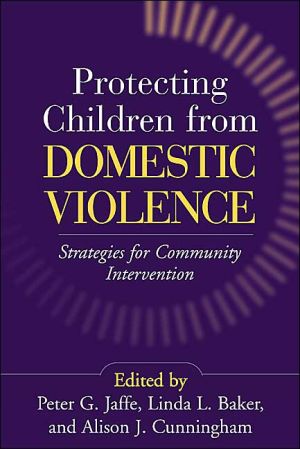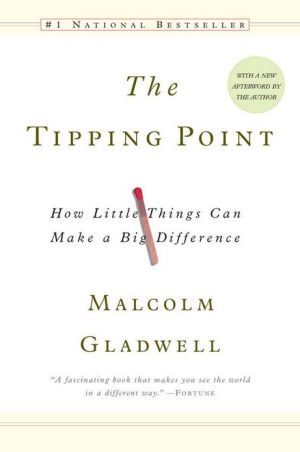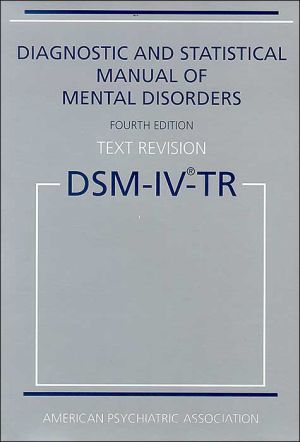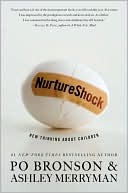Protecting Children from Domestic Violence: Strategies for Community Intervention
The impact on children of domestic violence has received increasing attention, but awareness of the problem has not always translated into public action. This forward-thinking volume brings together leading mental health, legal, educational, and social services professionals from the U.S. and Canada to demonstrate how the problem of violence in the home can best be mitigated through community collaboration. The book provides an understanding of the effects of childhood exposure to domestic...
Search in google:
The impact on children of domestic violence has received increasing attention, but awareness of the problem has not always translated into public action. This forward-thinking volume brings together leading mental health, legal, educational, and social services professionals from the U.S. and Canada to demonstrate how the problem of violence in the home can best be mitigated through community collaboration. The book provides an understanding of the effects of childhood exposure to domestic violence; considers the most promising assessment approaches; and examines specific interventions with victims and offenders, ranging from individual and group approaches to broader efforts involving schools, police, courts, and the media. Also addressed are the complexity of working with families from diverse cultural backgrounds and the often-ignored subject of how to enhance the roles of fathers in their children's lives.
Protecting Children from Domestic Violence\ Strategies for Community Intervention \ \ The Guilford Press\ Copyright © 2004 The Guilford Press\ All right reserved.\ ISBN: 1-57230-992-X \ \ \ Chapter One\ Purpose and Overview \ Peter G. Jaffe, Linda L. Baker, and Alison J. Cunningham\ From a historical perspective, domestic violence services and innovative practices have developed dramatically. The first North American shelters for abused women opened their doors less than 30 years ago. It was only 20 years ago that the issue was raised in the Canadian parliament by MP Margaret Mitchell, to a chorus of inappropriate comments ("Do you beat your wife, Charlie?") and laughter. The laughter has stopped and been replaced by a clear commitment by all levels of government as well as the general public that domestic violence is a serious criminal and social problem.\ The initial progress in the field of domestic violence was in public awareness, police and court responses, and services for victims and perpetrators. More recently, there is an increasing focus on the plight of children exposed to domestic violence. Major conferences and publications in the past decade document the impact of domestic violence on some children's emotional, cognitive, and behavioral adjustment at different stages of development (e.g., Jaffe, Wolfe, & Wilson, 1990; Geffner, Jaffe, & Sudermann, 2000; Graham-Bermann & Edleson, 2001; Groves, 2002). Awarenessabout the special needs of abused women and their children sparked a tremendous level of research, intervention, prevention, policy, and legislative advances. The fact that children's issues reached unparalleled heights in public consciousness was reflected by the Ontario government's May 9, 2002, speech from the throne, which included the following words:\ Every year, thousands of children see violence in their houses. These children are at risk and often continue a legacy of family violence themselves. Your government will continue to help children who are trapped in violent family situations.\ The idea for this book evolved from the 2001 International Conference on Children Exposed to Domestic Violence held in London, Ontario, Canada. Almost 1,000 people from Canada, the United States, as well as 14 other countries, gathered to focus on the plight of abused women and children. The volume is dedicated to expanding our understanding and community collaboration in responding to children and their parents in homes where domestic violence takes place, and it addresses the following three themes: First and foremost, we must find effective ways to end domestic violence to eliminate the tragic toll of lives and human suffering associated with it. Second, successful interventions must address not only the needs of children but also their parents, who are the adult victims and perpetrators. Strategies that see children as independent from their parents will fail to offer meaningful safety and healing interventions. As a third theme, we searched for "promising practices" to recognize the reality that there is insufficient research and evaluation to definitively conclude what is "best." We acknowledge our progress with an optimistic caution that we have many gaps in knowing which community responses are most effective in helping children and their parents end the violence in their lives.\ This volume is divided into three parts. The first part focuses on critical issues in successful interventions with children. The second part examines current thinking on interventions with adult victims and perpetrators. Examining the responses of the justice system and human services to children exposed to violence is the theme of the third part. Finally, we offer a concluding chapter to share our ideas about future directions in this field.\ OVERVIEW OF THE CHAPTERS\ In Chapter 2, Jeffrey L. Edleson addresses the important question of whether children exposed to domestic violence should be deemed to be in need of protection by the state. He argues that, based on the literature and the dreadful experiences of his home state, Minnesota, there can be more harm than good done by this legislative and policy change. He outlines a cautious and reasoned approach that demands a broad array of voluntary services for both children and their mothers and that recognizes the differential impact of domestic violence and the diverse range of circumstances in these families.\ In Chapter 3, the late B. B. Robbie Rossman (to whom this book is dedicated) and her colleagues outline their thoughts on the best assessment approaches for young children exposed to domestic violence. This chapter highlights an overlooked population, since many agencies counsel older children and adolescents who have the language to describe the impact of domestic violence. Younger children may exhibit the trauma in ways that require differential assessment and intervention strategies.\ In Chapter 4, Diane L. Davis describes her pioneering work in developing group intervention programs for adolescents. As police, communities, and the courts recognize that domestic violence is often exhibited in adolescent relationships as "dating violence," there is a need to have programs like the one Diane Davis outlines for this population. The model as well as some of the critical issues in the intake and assessment process is described.\ In Chapter 5, Sandra A. Graham-Bermann and Hilda M. Halabu from the University of Michigan discuss an often ignored topic: making our interventions culturally relevant. Based on their model program for children exposed to domestic violence, the authors illustrate how practitioners may have to rethink the "one-size-fits-all" approach for children. In giving examples of their clinical challenges, the authors raise issues for all of us to consider when intervening with children from diverse cultural backgrounds.\ Chapters 6 and 7 address the critical issues of safety planning and risk assessment in domestic violence cases. In Chapter 6, Jennifer L. Hardesty at the University of Illinois at Urbana-Champaign and Jacquelyn C. Campbell of Johns Hopkins University review the importance of safety planning for abused women and their children. Building on the development of the "Danger Assessment Scale," the authors delineate the role that children can play in their own safety planning. Chapter 7 expands this theme by exploring the risks that batterers may pose for their partners and children. Lundy Bancroft and Jay G. Silverman, from Boston, summarize key elements from their recent book entitled The Batterer as Parent (Bancroft & Silverman, 2002). The authors point out that in our focus on perpetrators of domestic violence as spouses, we ignore, at the children's peril, the harm engendered by them as parents in both subtle and direct ways.\ Chapter 8 offers a positive view of the need to offer rehabilitation to abusers, not only as spouses but also as parents. Oliver J. Williams from the University of Minnesota and his colleagues Jacquelyn Boggess (The Center for Fathers, Families, and Public Policy, Madison, Wisconsin), and Janet Carter (Family Violence Prevention Fund, San Francisco, California) build on the existing fathering movement to encourage men to play an active and nurturing role in their children's lives. The authors argue that all too often fathers' roles are ignored or dismissed in the face of the reality that many men want to change their traditional roles. Some abusers can be engaged in interventions that link their childhood to the childhood they are creating for their children.\ In Chapter 9, Melpa Kamateros continues this theme by profiling her innovative programs in Montreal that provide outreach services to various ethnic communities. She and her colleagues at The Shield of Athena Family Services developed creative strategies to ensure that new Canadians recognize the harm inherent in domestic violence and the importance of reaching out to appropriate community services.\ In Chapter 10, Miriam Berkman, Robert L. Casey, Steven J. Berkowitz, and Steven Marans profile their innovative program bridging Yale's Child Study Center and the New Haven, Connecticut, police. The authors remind us that the police play an essential role in responding to children traumatized by domestic violence. Through case illustrations and a literature review, they delineate the unique opportunity for partnerships between police and mental health professionals in helping these children and families in crisis.\ Chapter 11 examines the family court response to domestic violence in the context of child custody disputes. Martha Shaffer from the University of Toronto and Nicholas Bala from Queen's University provide a Canadian legal perspective on how the courts are beginning to recognize that perpetrators of domestic violence may not be appropriate custodial parents and may require supervised visitation. Based on a review of recently reported cases, the authors conclude that the Canadian family courts are making slow progress in recognizing the plight of children exposed to domestic violence, similar to advances in the United States, Australia, and New Zealand.\ Similarly, in Chapter 12, Billie Lee Dunford-Jackson examines the family court system from an American perspective. Specifically, she reviews the varied legislative approaches undertaken by numerous states to address the issue of children exposed to domestic violence, with the goal of protecting children from harm. Billie Lee emphasizes that many of the proposed legislative changes are ineffective because the various levels of government fail to communicate with one another and coordinate services. She concludes that formulating beneficial interventions requires avoiding the "one-size-fits-all" approach and instead acknowledging that every family, situation, and set of needs is different.\ Chapter 13 summarizes the potential role of the school system in preventing domestic violence. The five authors represent a collaboration of the Centre for Children and Families in the Justice System, the University of Western Ontario, and the Thames Valley District School Board. The authors offer a blueprint for schools to be more proactive in addressing violence prevention efforts and recommend that healthy relationships become the fourth "R" for the education system. The authors challenge schools to be active partners in ending domestic violence by effective early intervention, innovative curriculum, and community collaboration in prevention.\ Chapter 14 affords the editors an opportunity to outline our conclusions from the diverse chapters in this volume. We formulate our ideas in a synopsis of future directions in this rapidly developing field.\ We trust this book will have a special place in the library of practitioners and policymakers, helping them to consider some of the far-reaching implications of children's exposure to domestic violence. We feel assured that readers will be challenged and stimulated to build on the existing knowledge base to develop better community responses for these children. We believe that we are at a critical juncture, when tremendous change is possible in how we consider domestic violence and its inevitable harm on children and the ripple effects it has on our communities.\ (Continues...)\ \ \ \ \ Excerpted from Protecting Children from Domestic Violence Copyright © 2004 by The Guilford Press. Excerpted by permission.\ All rights reserved. No part of this excerpt may be reproduced or reprinted without permission in writing from the publisher.\ Excerpts are provided by Dial-A-Book Inc. solely for the personal use of visitors to this web site. \ \
1Purpose and Overview32Should Childhood Exposure to Audit Domestic Violence Be Defined as Child Maltreatment under the Law?83Young Children Exposed to Adult Domestic Violence: Incidence, Assessment, and Intervention304Group Intervention with Abusive Male Adolescents495Fostering Resilient Coping in Children Exposed to Violence: Cultural Considerations716Safety Planning for Abused Women and Their Children897Assessing Abusers' Risks to Children1018Fatherhood and Domestic Violence: Exploring the Role of Abusive Men in the Lives of Their Children1209The Ethnic Media Outreach Project: "Canada Is a Country for Women"14110Police in the Lives of Children Exposed to Domestic Violence: Collaborative Approaches to Intervention15311The Role of Family Courts in Domestic Violence: The Canadian Experience17112The Role of Family Courts in Domestic Violence: The U.S. Experience18813The Fourth R: Developing Healthy Relationships through School-Based Interventions20014Future Directions in Ending Domestic Violence in the Lives of Children221Index231
\ From the Publisher"For far too long, children exposed to domestic violence have been overlooked--if not forgotten--by those who should be protecting them and providing effective interventions. This book is a welcome and invaluable resource for a range of practitioners working in the area of domestic violence. Readers from different fields will be enlightened as to the roles each might play in addressing children's needs. As a text, the book will be useful in the classrooms of law schools, law enforcement training academies, and graduate schools of social work and psychology, to name just a few."--Honorable Peter C. Macdonald, (Retired), District Judge, Third Judicial District, Commonwealth of Kentucky; Co-chair, Family Violence Committee, National Council of Juvenile and Family Court Judges\ "This volume brings together the latest research about the effects of domestic violence on children and how our policies and programs should respond. It is a critical desk reference for policymakers, practitioners, researchers, and educators who care about and advocate for the safety of children."--Diane DePanfilis, PhD, MSW, Institute for Human Services Policy, University of Maryland School of Social Work\ "An important contribution. This comprehensive volume tackles ongoing and emerging issues--such as whether childhood exposure to domestic violence should be defined as maltreatment--and fills in gaps in the existing domestic violence literature. The book also addresses assessment and intervention from the individual to the community levels. It will be a valuable resource for professionals in the areas of child welfare, intimate partner violence, law enforcement, and family and criminal law, as well as for faculty in social work, child development, criminal justice, and related programs."--Caroline L. Burry, PhD, School of Social Work, University of Maryland, Baltimore\ \ \ \ \ \ \ Prevention Researcher"This engaging and readable book is a 'must-have' volume for practitioners or policymakers working with or planning for the welfare of children and adults affected by domestic violence....As a researcher who has worked in the areas of family violence and child welfare for more than a decade, I would consider this volume as a comprehensive survey of the state of knowledge about promising strategies for protecting children from domestic violence....This book is a highly recommended tool for anyone with a personal or professional interest in the subject of helping children cope with violence in their families."--Prevention Researcher\ \








